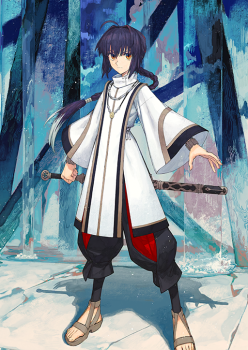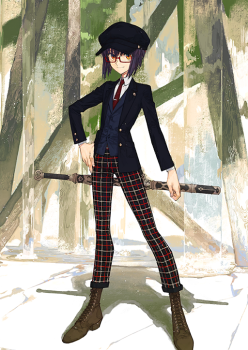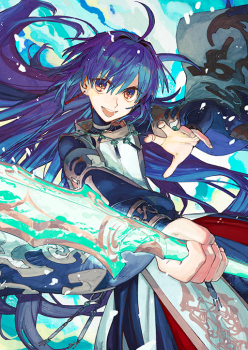Yamato Takeru has very very good refund even by Arts standards—the biggest reason they can farm 90++ nodes at reasonable investment is that they can run The Black Grail and still loop regardless of wave composition. Fitting with their theming as an ST Servant in disguise, they can even loop 1/1/x nodes CE-less with the right setups—though it requires either Habetrot or Summer Chloe.
There are two options for CE-less 1/1/x looping with Yamato Takeru. These both assume a 1.0 multiplier for NP gain, as Yamato Takeru is most likely to be used against Lancers—though this can also work against Berserkers with sufficient overkill.
The Habetrot setup relies on the extra charge granted by Yamato Takeru’s first skill when an ally dies. You run Castoria/Yamato Takeru/Castoria/Any 50% charger (though ideally Oberon)/Habetrot, with Mana Loading maxed out on Yamato Takeru. On turn 1, you use Yamato Takeru’s first skill’s battery, as well as all three skills from one Castoria, and the other Castoria’s Arts buff, bringing you to 100% charge. You then plug the first Castoria—the one whose batteries have been used—out for Habetrot. Habetrot uses her third skill on someone other than herself. If you think you may need card stretch for wave 2, you can also use Habetrot’s first skill on Yamato Takeru (for extra star gen), and if you’re short on damage on wave 1, you can use Habetrot’s second skill to enable a Habetrot NP (which should come after Yamato Takeru’s in order to benefit from Yamato Takeru’s NP’s debuffs). Ideally neither of these are necessary, but they do technically raise the team’s damage ceiling slightly.
On the first turn, Yamato Takeru’s NP refunds 23.4% before overkill against a single target. When you factor in the one hit of overkill that’s guaranteed so long as the NP kills its target, it refunds just under 25%. Habetrot’s third skill kills her, granting another 25% and bringing Yamato Takeru to 50% charge. Habetrot leaving the field also brings your 50% charger in. The remaining Castoria uses her batteries to take Yamato Takeru to 100%. With the extra NP gain buff from Castoria, Yamato Takeru refunds 28.8% before overkill, which becomes 30.6% with the guaranteed hit of overkill factored in. For the final turn, Yamato Takeru uses their third skill—which has the added benefit of leaving their mana burst for the final wave—and your 50% charger makes up the difference. Even though the extra 20% charge isn’t necessary, Oberon is far and away the best choice for this, as End of the Dream can double Black Grail’s damage boost. The caveat to this, of course, is that spacing out the batteries as necessary to maximize refund leaves Yamato Takeru short on steroids for waves 1 and 2, which may make hitting damage thresholds on early waves tricky.
The Chloe setup, meanwhile, does require Oberon. The team is Castoria/Yamato Takeru/Castoria/Oberon/Chloe. On turn 1, you use both Castoria Charismas, both Castoria Arts buffs, and one Castoria’s targeted battery. You then plug the Castoria whose targeted battery you used out for Chloe, and you use Chloe’s first skill. Yamato Takeru again refunds about 25%—and they also gain a manuscript stack from Chloe. On turn 2, Chloe uses her second and third skills, granting 10% charge and some extra damage, and getting herself ready to leave the field. The remaining Castoria uses her targeted battery to bring Yamato Takeru to 50%, and Yamato Takeru uses both of their batteries to reach 100% and NP again. Yamato Takeru refunds 32.3% before overkill, which is more than enough for Oberon’s 70% batteries to make up the difference and secure the loop. This brings a fair bit more damage than Habetrot does—Chloe more than makes up the difference on wave 3 even though Yamato Takeru has to Mana Burst on wave 2—so while it doesn’t leverage Yamato Takeru’s unique gimmick, it’s solidly the better setup assuming you have Oberon and Chloe.
Both of the above setups come with a catch, though, which is that you can’t run a full set of 5* CEs in those teams with the current cost cap, even with Mash as your sixth Servant. It also locks you out of an extra slot for bond farming, and it’s somewhat slower than even a typical plug setup, as you have to wait for two Servants to swap out, rather than just one. Having 100% guaranteed CE-less looping is a cool trick and not that many Servants can do it, but there are other Servants who can—notably, Arc and CasCu can both do it without even needing plug, provided they have the damage—so your mileage may vary with regards to how useful this is.
All of that said, a conventional Castoria/Castoria/Oberon team can farm anything that has at least 3 enemies in the first two waves, provided Yamato Takeru has the damage. For a 2/1/x setup, assuming you need to maximize your wave 1 damage, you use both Castorias’ Charismas and Arts buffs, plus Yamato Takeru’s Arts buff, which allows Yamato Takeru to refund about 37% off the two enemies collectively—20% from the main target and 17% from the secondary target, with the discrepancy between them caused by the ST Arts debuff on Yamato Takeru’s NP. With the guaranteed hit of overkill, this comes to 39%. On turn 2, you use the 20% batteries from both Castorias, and you plug a Castoria for Oberon, who uses his own 20% battery, bringing Yamato Takeru to 99%, which rounds to 100%. Yamato Takeru then refunds 32% against the single target, which allows their first skill plus Oberon’s 50% battery to secure the loop.
For a 1/2/x setup, the same start refunds 20% on the first wave. Yamato Takeru then uses their own 30% battery, and you use both Castoria batteries plus Oberon’s 20% charge. With all buffs in play, Yamato Takeru refunds 59% off two enemies before overkill—32% off one target and 27% off the other—and Oberon’s 50% battery secures the loop. Any more forgiving node composition is trivial, and as you add enemies you can remove battery from the equation, dropping Mana Loading or trading Oberon for a less-efficient charger.
Yamato Takeru’s NP gain is so good, in fact, that against 3/3/x waves they can loop CE-less, with any mystic code, with just double Castoria. On wave 1, you have Mana Loading, you use both Castoria Charismas, and you use a Castoria 20% battery, as the NP gain buff gives you a lot more refund than the extra Arts buff on Yamato Takeru’s third skill. Yamato Takeru refunds just over 60% before overkill, with 23% coming from the main target and 19% (give or take) coming from each of the secondary targets. You then use the remaining Castoria battery and Yamato Takeru’s own 20% battery to reach 100% charge, and with all buffs in play Yamato Takeru refunds a whopping 85%, with 32% from the primary target and 26.5% from each of the other two. Yamato Takeru’s 30% battery easily secures the loop. Even if you flip the order of Yamato Takeru’s skills, using the 30% battery on turn 2 and saving the Mana Burst for maximum damage on turn 3, they still loop, as they refund 75% before overkill without their own Arts buff in play, and even a single hit of overkill on each target brings them to 80%.
This is a very long way of saying Yamato Takeru’s loop specs are kind of absurdly good, and unlike other servants with similarly powerful looping—Nito for instance—Yamato Takeru’s damage isn’t really penalized for it. They do hit for a lot less damage against their secondary targets, but most of the time you’re only dealing with one really bulky enemy at a time anyway. If they do enough damage, they can always farm, which is a good place to be—damage is mostly solvable with NP levels and/or a future Interlude, while NP gain is much harder to address.
For CQs, all of the above setups can work well. Yamato Takeru is well-positioned to finish fights quickly, snowballing their own damage from turn to turn. If you aren’t using Oberon—and really for CQs you shouldn’t be—you also benefit from Arts’s natural ability to shift into defensive setups. In CQs, you can count on benefitting from cards, which means Arts Servants don’t really need Oberon’s extra charge. You’re usually better off slotting in Tamamo, Reines, or Lady Avalon as your plug support and relying on drawing an Arts card or two, so that if you can’t clear in three turns you can switch to stalling. Yamato Takeru doesn’t even really need to transition to hard stall, either, as their NP gain is generically great and a good chunk of their steroids are tied to their NP. Much like Muramasa, Yamato Takeru should be able to NP nearly every turn, so even a little bit of sustain from the Arts shell can likely get them through any fight that doesn’t kill you in a single hit or drag on for double-digit numbers of turns.
They’re also a pretty self-sufficient unit, which means they can do well in budget or alternative teams. Their lack of utility means they benefit from having a pocket Sherlock who can help them get past defensive buffs, and their high NP hit-counts mean they pair nicely with Lanling. In fact, a Lanling/Yamato Takeru/Sherlock team should have a decent balance of card damage and NP damage, while also ignoring many gimmicks that come their way. Looking specifically at free Servants, Xu Fu pairs very nicely with Yamato Takeru, as does Mozart. As alluded to earlier, Habetrot has great synergy here, providing useful buffs and a lot of extra defense while also giving a controllable de facto 25% charge. Any low-rarity Servant who can taunt or is otherwise likely to die quickly effectively provides extra charge to Yamato Takeru, too, which helps to offset the pain of losing high-rarity chargers.
Overall, Yamato Takeru is extremely flexible. They’re particularly well-suited to just slashing their way through whatever they encounter. In an optimized team, they can do basically anything other than counter gimmicks, and at the lower end they turn weakness—fragile teammates who struggle to stick around for multiple buff cycles—into an advantage. Their weird pseudo-ST NP also means they can work in both AoE and ST contexts, albeit not quite as effectively in either case as a specialist. The long and short of it is you can throw Yamato Takeru into just about any reasonably-constructed team and expect them to do well.
Yamato Takeru’s loop specs are so good there’s no reason not to give them The Black Grail as their CE if you can. Even if you’re “stalling,” Yamato Takeru much prefers a style of stall that accepts incidental damage in favor of hitting harder and more often, which means the Black Grail’s demerit is less likely to matter than it might in an invincible team—and if you’re running Castoria with Tamamo or Lady Avalon, the supports can heal the damage off anyway.
If you don’t have Black Grail, Heaven’s Feel is the next best thing. Formal Craft is also pretty good, especially if MLB and leveled, and Mark on a Smiling Face pairs nicely with Yamato Takeru’s refund-heavy focus. Essentially, unless you have no native chargers and can’t grab a Castoria off support for some reason, you just don’t need starting charge, and you’re best-off picking whatever CE is going to do the most for Yamato Takeru’s damage output.
There are two main ways to approach CCs for Yamato Takeru: utility and crits. Given Yamato Takeru’s lack of antigimmick tools, CCs that can handle unforeseen circumstances are highly beneficial. Coffin of the Fall is a particularly good pick for Yamato Takeru’s Busters, as it removes Debuff Immunity from the target, meaning you can place it before Yamato Takeru’s NP in order to clear the way for the NP’s Arts card resistance debuff. This CC has the added benefit of increasing crit damage against Good enemies, and Yamato Takeru’s innate crit damage buffs are low enough that it’s a meaningful benefit. Aside from that, removing defensive buffs is generally more useful than removing offensive ones, with the possible exception of crit chance up (which can be very dangerous for an Arts team that’s not relying on being untouchable), and many of the buff removal CCs have useful secondary effects tied to them as well. Good Night Viy is a particularly good pick, as it removes crit chance up buffs, and then, if successful, reduces the target’s Arts card resistance, functionally increasing Yamato Takeru’s damage output. Debuff removal CCs—and particularly offensive debuff removal CCs—can also be good for ensuring consistency.
The other approach to picking CCs for Yamato Takeru is to focus on crits. Star gen CCs can help them get access to stars, which in turn increases effective damage output and NP gain, especially given the weak base NP gain on their cards. Alternatively, crit damage CCs have an outsized impact on Yamato Takeru given their very low in-kit crit buffs. Star weight CCs are also better than usual here, as Yamato Takeru has no way of drawing stars to their own cards. If you were to put A Kind Wish on one of their Arts cards, for example, that card would be much more likely to crit if you generate a small handful of stars.

 4
4 4
4 3
3 5
5 8
8

































